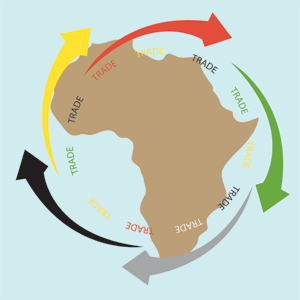
Africa: Situating Economic Partnership Agreements in Sub-Saharan Africa′s Evolving Trade Landscape
While EPAs are finally being concluded, the global and African landscapes are being fundamentally reshaped by the connected phenomena of mega-regional trade negotiations and China′s rapid expansion into the continent. How can the major developed countries negotiating mega-regional and African deals, respond to these developments?
After years of acrimonious negotiations, Economic Partnership Agreement (EPA) negotiations seem to be finally drawing to a successful close. While the overall picture for sub-Saharan Africa is quite murky for those not actively involved in the negotiations, the main regional groupings seem to have concluded negotiations.
It looks likely that most non-least developed countries (LDCs) will be integrated into the EPA net, whereas LDCs (even those not covered by an EPA) have guaranteed full access to the European Union (EU) market via the Everything but Arms (EBA) preferential access scheme. And while the EPA agreements are primarily centered on goods market access, they include rendez-vous clauses containing the possibility of broadening and deepening the arrangements in the future.
Yet the strategic landscape enveloping EPA negotiations has changed fundamentally since their inception more than a decade ago. Central to this is the recent emergence of ′mega-regional′ trade negotiations, and China′s rapid ascent in the African trade and investment landscape.
′Mega-regionals′ attract various definitions. In my view they are preferential trade agreements (PTAs) involving three or more countries; constituting a quarter or more of world trade; and entailing deep, behind the border regulatory commitments. Thus only the Trans Pacific Partnership (TPP) and the Transatlantic Trade and Investment Partnership (TTIP) qualify.
Led by the USA, the TPP and the TTIP are wide in scope, deep in ambition, and laden with many implications for non-party states and for the global trading system.
Partly a product of the impasse in the World Trade Organization (WTO), they have sucked negotiating energy out of the WTO thereby contributing to the difficulties in concluding the Doha round; even as they are strategically aimed at reinvigorating their leadership of the WTO down the line through the process of ′competitive liberalisation′ (see Box).
These PTAs are also a product of China′s geopolitical rise, prompting the USA and EU to lock-in access to key markets and regions. China and other major developing economies are responding with initiatives of their own, such as the Regional Cooperation in Asia and the Pacific (RCEP) negotiations. Hence there is renewed impetus behind PTA negotiations across the world.
The notion of ′competitive liberalisation′ is associated particularly with Fred Bergsten, former Director of the Petersen Institute for International Economics, and Richard Baldwin.
The former argues that as the USA secures PTAs with other countries, so those countries become like-minded with the USA and seek to form PTAs along similar lines with third parties. Soon those left outside emulate the PTAs, and ultimately the logic finds its way back into the WTO in the form of new agreements.
Baldwin identified the ′juggernaut′ effect, whereby major multinational companies seek regulatory convergence in order to smooth the operation of their global value chains, and lobby host governments to provide it particularly through mutual recognition agreements. This pressure finds its way into PTAs, thereby creating a juggernaut effect reinforced by competitive liberalisation. [See Richard Baldwin "A Domino Theory of Regionalism", NBER Working Paper, 4465, 1993].
Generally impact assessments on the TPP and TTIP negotiations concur that the effects of tariff liberalisation on negotiating member states will be modest. Similarly there is some concurrence that trade diversion impacts on outsiders will be relatively small, particularly for African states since they mostly do not directly compete with those party to the talks.
However, some countries are likely to suffer from preference erosion in key commodities, limited by the fact that tariff barriers in the EU and USA markets are mostly already low. Some studies argue that trade creation impacts, for example increased demand for natural resources in parties to the two agreements, may outweigh those of trade diversion for outsiders, yielding net positive gains.
Crucially, all studies concur that removal of non-tariff barriers to trade, particularly through regulatory harmonisation, will have the most significant impacts both on parties and non-parties, although the effects are very difficult to measure let alone predict.
Some worry that standards will be raised so high that non-parties will be locked out of erstwhile markets; others argue that mutual recognition agreements backed up by extension of conformity assessments amongst negotiating parties will increase market access for outsiders substantially. The devil is in the detail, and only product specific assessments will reveal the likely impacts.
Either way there is concurrence that regulatory standards negotiations are very much here to stay as part of the modern trade diplomacy landscape; a fact that African states have largely avoided in the EPAs, but will have to adapt to.
It is important to understand potential scenarios for how mega-regionals may unfold, since the strategic implications for African states vary substantially. In a full success scenario, competitive liberalisation would march on triumphant, with the regulatory agenda manifesting strongly in the WTO and in demands for reciprocity from African states, which they would find difficult to resist.
Under a partial success scenario important aspects of the regulatory agenda and trade impacts described above would manifest, but Western hegemony over the global trading system would not have been decisively reasserted. This would offer a ′balance of power′ prospect to African states, nuanced according to sub-region and degree of exposure to Chinese influence in particular.
But the search for reciprocity in bilateral trade relations would move up the major developed countries′ radar screens, with attendant negative implications for preference schemes.
Under a failure scenario, the implications just described would manifest quicker and more intensely as the Western powers scramble to shore up traditional ′spheres of influence′. Furthermore, and particularly if the current Chinese economic reform programme is successful, African countries would face a China dominated trading system earlier, perhaps, than previously anticipated. In all three cases the shifting sands of geopolitics are set to intrude ever more sharply into African trade and investment relations.
The backdrop to the mega-regional effort is that sub-Saharan African nations are concurrently engaged in discussions with major partners over institutional arrangements of long-term developmental and strategic importance.
The African Growth and Opportunities Act (AGOA) - the centrepiece of the USA′s economic relations with the region since 2000 - is up for renewal in 2015 against the backdrop of a fair degree of uncertainty regarding the terms of any new agreement.
AGOA has been characterised by its unilateral and non-reciprocal nature, features that are up for discussion, specifically with regards to sub-Saharan Africa′s biggest economies and most dynamic markets. An important factor behind American calculations is that the EU will shortly cement the EPA process, which is built on reciprocity, hence preferential access to African markets for European firms.
Since 2000, the Forum on China-Africa Cooperation (FOCAC) has served as the main stage for Sino-African bilateral relations. Recently, there have been moves to formalise trade and investment arrangements with African regional groupings through initial Framework Agreements with the East African Community (EAC) and the Economic Community of West African States (ECOWAS). China, too, may start to demand reciprocity with certain partners in response to EPAs.
So shifting geopolitics are manifesting at a time when the continent′s trade and investment patterns are undergoing a profound shift from traditional economic partners to intensified relations with fast-developing centres of world commerce.
The EU as a bloc remains sub-Saharan Africa′s largest trading partner, yet its share of total trade halved between 1989 and 2011 from 50% to 25%. In 2011, the USA accounted for 12%, while China had become sub-Saharan Africa′s single country biggest bilateral trading partner with 15% of the region′s total trade. The speed and scale of China′s engagement with the continent has been a game-changer.
What can the EU and USA do to assist African states?
From the standpoint of sub-Saharan African states, and regardless of which mega-regional agreements negotiation scenario prevails, the immediate tendency may be to gravitate towards European and US partners - especially if existing preference schemes are strengthened and the EU makes African economic development a strategic priority. In this light, generous preference schemes in developed markets with rules adapted to the realities of modern trade could spur African export diversification.
The TTIP, in particular, could provide an opportunity for the EU and the USA to jointly revisit trade preference schemes to support the development objectives of sub-Saharan African low-income countries.
The Trans-Atlantic partners apply distinct non-reciprocal arrangements through AGOA and EBA that offer special access to African nations and least developed countries. Liberal access to developed markets could help stimulate investment and job creation into African LDCs agricultural, manufacturing and service export sectors.
However, despite their successes, both schemes suffer from sharp limitations: AGOA excludes and applies tariff quotas to key products the region can produce competitively; EBA provides full duty-free quota-free coverage but only to countries classified as LDCs, thereby driving an arbitrary wedge into various African regional groupings; the rules of origin required for product eligibility militate against the development of value chains; and AGOA′s annual review mechanism added to the uncertainty of the scheme′s renewal post-2015 reduces security of access.
Harmonisation of preference schemes does not seem to be on the TTIP′s agenda. Nonetheless, the EU and the USA could mutually recognise requirements covering rules of origin under AGOA and EBA.
This would reduce information costs and ease compliance procedures for African exporting firms, and potentially allow preference-qualifying products imported from African countries to be granted reciprocal access to EU and USA markets.
What can Africans do?
While sub-Saharan African economies have grown faster than other regions of the world in recent years, primary commodities have driven much of this growth.
Most African nations need to implement reforms that improve their business environment and attractiveness as investment destinations so they can develop their potential in manufacturing activity and agricultural productivity. Modernised infrastructure and backbone services (logistics, telecommunications and transportation) are further preconditions for competitiveness and the ability to tap into sophisticated global value chains.
Securing greater depth and coherence to existing regional integration efforts will also be an important element in creating an environment conducive to the expansion of value chains.
Currently weak regional integration is partly driven by the lack of complementarities between the region′s economies, but also by the prevalence of high barriers to trade that severely restrict the ability to form regional value chains. Thus Africa will remain dependent on external forces for a long time. However, initiatives at the regional level could be used as laboratories for reform and for building regional value chains with an eye on graduation into global production networks.
By All Africa Published: Oct 24,2014
X
Please confirm If you want to unregister
X
You have been unregistered from gradlink







